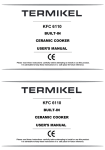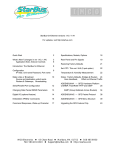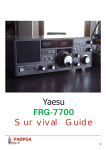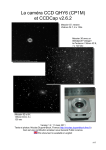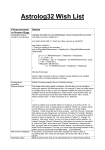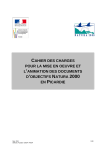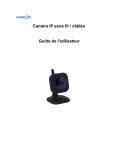Download redcat ALL-SKY-CAMERA USER MANUAL
Transcript
redcat ALL-SKY-CAMERA USER MANUAL 2012 Apr 01 (ver 1) www.redcat-sci.com www.lugonextlab.eu Warranty Prior to shipment, LugoNextLab equipment is thoroughly inspected and tested to applicable specifications. However, should equipment failure occur, LugoNextLab assures its customers that prompt service and support will be available. All equipment originally manufactured by LugoNextLab which is found to be defective will be repaired or replaced subject to the following considerations. In suspection of failure, contact LugoNextLab ([email protected]) yielding unit model, serial number, and a description of the failure symptom. We will assign a Return Material Authorization (RMA) number which must appear on the outer label of the return package. All units/components should be properly packed for handling and returned with freight prepaid to the LugoNextLab designated Service Center, and will be returned to the customer's/user's site freight prepaid and invoiced. A Coverage of Two Years from shipping is guaranteed. Returned unit/part will be repaired and/or replaced at LugoNextLab with no charge for technicians actions or parts not excluded by warranty. Equipment provided but not manufactured by LugoNextLab is warranted and will be repaired according to the terms and conditions of the respective equipment manufacturer's warranty. General Under this Warranty, liability of LugoNextLab is limited to replacing, repairing or issuing credit (at LugoNextLab discretion) for any products which are proved to be defective during the warranty period. In no case is LugoNextLab liable for consequential or special damage arriving from use or misuse of this product. The customer is responsible for all charges caused by modifications or additions to LugoNextLab equipment not approved in writing by LugoNextLab or, if in LugoNextLab opinion the equipment has been subjected to abnormal use. "Abnormal use" for purposes of this warranty is defined as any use to which the equipment is exposed other than that use specified or intended as evidenced by purchase or sales representation. Other than the above, no other warranty, expressed or implied, shall apply to any and all such equipment furnished or sold by LugoNextLab. 2 General features. The redcat ASC0b all-sky-camera performs all-sky observation through a web camera (AXIS P1343) coupled with a high quality fish-eye lens (Nikon FC-E8) covering the whole hemispheric field of view (180°). The system works with continuous power supply than can range between 9V and 15V (default 12 V) with a maximum power absorption of nearly 20 W. Depending on requirements the camera can be equipped with a temperature control system that switch on electronics only when the internal temperature reaches a security level (~ -10°C). On the other hand, a 10 W (at 12V) warming system is programmed to be switched-on below + 5°C. In midlatitude sea level normal operations the heating system was considere to be unnecessary so that it is installed only on specific requirements. Being typical absorption rate well below 5 W, it is possible to install the camera on field skipping power cabling using solar or wind generated energy. The system is equipped with a 4GB SDCARD for local data storing (if based on Axis P1343). Adopting Axis 211W (on requirement) or a commercial Wi-Fi bridge it is possible to interface the system with a local wireless network, skipping also network cable connections. A power green LED is globed into the front push button, included for future development of the electronic (e.g. it does not take any ACTIVE function). System is switched-on/off by plugging power cable, but it could be rebooted through telnet communication (login and run restart the camera go to reboot command). Alternatively, to System Options > Maintenance . perform a correct restart. Do not use Restore nor Click Default Restart to buttons because custom system settings, in particular inherent to the band moving, will be 3 permanently lost. Accurately water sealed chassis can be provided both in aluminium or steel, Ethernet and power supply connectors follows IP-68 requirements to safely operate instruments on field. ASC0b is provided with an integrated levelling system. The web cam is based on a embedded Linux system (http://busybox.net) on which a lot of TCP/IP services run. Among others they are http, ftp, smtp, telnet, ssh, ntp time server. Dimensions: Height=350 mm, Maximum Diameter=160 mm, Weight 3 kg. Web, Video and Images. Video and image encoding of ASC0b is highly configurable through the web based interface to the camera settings. The unit is is shipped with DHCP enabled and typically could be directly localized at http://axis-MACNUMBER.local./view/viewer_index.shtml1 address after al least one minute after power up. In other cases, among Windows Axis Camera Management program, also Bonjour/uPnP/avahi-discover could be used on mac/win/linux respectively, to resolve the IP assigned to the camera by the DHCP server. It is possible of course to assign a static address (see SETUP > BASIC SETUP > 2.TCP/IP ). For all sky camera based on P1343 Axis web camera the maximum image resolution is 800x600 (JPEG). On the other hand, the camera is shipped with a default 640x480 resolution that could be adjusted following SETUP > LIVE 1 Or at axis-MACADR.local./pwdroot/pwdRoot.shtml (use root/redcat as first access credentials for http, ftp and telnet protocols). Twelve word MACADR corresponds to the serial number of the camera. Suggestion: communicate your mac address to your network manager: he probably could assign a “fixed” DHCP address to the camera. 4 VIEW CONFIG > Image Appearance . Do to the need of centre the whole sky image produced by the fish eye on the active area of the camera, a total of approximately 2202*3.14 ~ 1522 Kpixels (RGB) defines the image that will be analysed. Images of the sky (ground) could be uploaded periodically to an ftp server 3 (to be defined using SETUP > EVENTS > EVENT SERVER + EVENT TYPE ) for further analysis (maximum 1 minute periods, 10 minutes by default). Local storage is also possible because the camera could be equipped with an SD-CARD memory (optional). NOTE: Before removal, the SD card should be unmounted to prevent corruption of recordings. To unmount the SD card, go to Options > Storage > SD Card Setup > System and click Unmount. Sun shadowing. A scripting procedure (task suite) was developed and embedded on the camera to perform astronomical based shadowing of the fish eye lens in order to enhance the quality of the sky image collected (see Shadowing paragraph for further details). The quality of such enhancement is related to the atmospheric turbidity and sun elevation. Because of the ephemeris based sun shadowing, it is important to keep time correct so that, by default, redcat time is synchronized with a ntp time server (default: pool.ntp.org) that could be suited to custom settings (e.g. if the DHCP server provides a custom ntp server: follow BASIC SETUP > 3.DATE/TIME ). SETUP > The Timezone must be setted UTC with no daylight adjustment. A table of the azimuth angles (multiplied by N = 10250000 millisteps/rev) is 2 R = (D-40) / 2 with D=480 and 40 pixels due to top and bottom borders. 3 Server could also be http or smtp 5 included in the system at /usr/html/local/scripts/azi1.txt. It contains the hour of the year starting from 0000 UTC (hhhh time format, hours ranges from 0000 to 87604) and the corresponding azimuth sun angle (deg. from North - positive eastward) in millisteps. The iqbaltab.awk AWK script present on the product CD can be used to perform the calculation of such a table in case of need. Then, to upload a correct azi1.txt file the following steps should be performed: ftp IP_of_the_redcat > put local_azi1.txt_file > remote file: /usr/html/local/scripts/azi1.txt The revolution of the band is clockwise in northern hemisphere and counterclockwise in the southern hemisphere and is fixed on the electronic board. At this stage a switch of the revolution direction can be performed only by inverting one of the bi-polar stepper motor phase. Please refer to www.redcat-sci.com for switching direction. Installation. When installing the camera on field be sure to level it accurately using the three 50 mm 120° screw and then, to fix it with the two 70 mm M6 screw to a solid base. A 10mm monkey wrench could be useful on first installations due to a certain bolt hardness. ASC0b shadow-band is not equipped with a zero reference sensor, but it is important for image analysis and normal operations, to refer the front push button toward local South direction within a certain accuracy (± 10°). Of course the band will not shadow Sun on first installation. 4 In leap years maximum hour is increased to 8784. 6 IMPORTANT NOTE: DO NOT FORCE THE BAND BY HAND TO DIRECT THE SUN! GEAR INCLUDED IN STEPPER MOTOR WILL TURN PERMANENTLY DAMAGED. Enter the camera using telnet command with root/redcat access credentials, and keeping the live view opened on a web browser, perform the following steps: % telnet IP_of_the_redcat # cd /usr/html/local/scripts/ # ./task_continuous.sh The band will start running5, leave the band running until the sun is completely obscured and press CTRL+C to kill the script when satisfied. A second task, running in background (task_3.sh ), keep the band following the Sun accordingly to task azi1.txt file previously uploaded (use top or ps x | grep to see running tasks). Exit from the telnet session. An integration of these raw function on the web interface to ASC0b is going to be developed and available in next release of the firmware. Image analysis. The enclosed CD contains a set of scripts and programs for cloud cover analysis, that should be performed on a linux (windows-cygwin) personal computer running ImageMagick(c) (www.imagemagick.org). Fig.1 and Fig. 2 show an image of sky and a composited image of snow covered ground respectively, as acquired by the ASC0b. The camera is configured to automatically upload an image every 10 minutes to a 5 If it does not move try the command “killall iodserver” and perform again task_continuous.sh 7 password protected and serial number dedicate FTP server (ftp://redcatsci.com/input/). Images will be automatically analysed in terms of cloudiness and stored on output/ path of the same folder. It should be pointed out that, even than username and password are required to access the FTP server, the intrinsic weakness of the FTP protocol in terms of security could arise privacy arguments. Moreover images are accessed by redcat researchers to set up automatic programs that perform the above mentioned analysis. LUGONEXTLAB AND REDCAT-SCI.COM ARE NOT RESPONSIBLE FOR ANY INJURY DERIVED BY AN ILLICIT USE OF THIS UTILITY that is part of the product being every account couple with a unit serial number. Please visit www.redcat-sci.com for further details. It is of course possible to disable the uploading of the images on the standard ftp by accessing the liveview/setup pages: SETUP > EVENTS > EVENT TYPES > select “uploadsky” event > Modify > switch to “Never” on “Activation Type” section. 8 Fig. 1: Diurnal and urban nocturnal view of the whole sky taken by an ASC0b. It appears to be possible to follow night-time cloudiness if sufficient light pollution is present. Fig. 2: A snapshot time series of the ground status of a snow covered surface (an image every 6 hours, BSRN co. Concordia station Antarctica 75°S 123°E). An image analysis session. A simple cloud detection algorithm have been developed an shipped along with the CD of the ASC0b camera. Suite is composed by • a bash scripts (conv.sh) • a gnuplot script (conv.plt) • a fortran program (conv-detect-cloud.f) Gnuplot (Ver >= 4.2) (www.gnuplot.info) and Imagemagick (convert tool: www.imagemagick.org) should be installed on the system, they are available for 9 both windows and Linux systems. It is sufficient to call conv.sh with an image filename as first argument and a number from 1 to 5 as second argument (corresponding to 5 different cloud schemes). All clouds schemes are applied but just that selected is used for plotting results. Better performance was obtained using the conversion scheme 5, based on HUE parameter. The plotting script was arranged to give better eye-candy results for this choose. Being all source codes available to users, any custom adjustment or definition of new cloud detection schemes, could be easily implemented. ./conv.sh image.jpg 5 produces image.o.jpg output file. An example is given in Fig. 3. Fig. 3: An original jpg image produced by the web camera (left) and the analysis of cloudiness given by the “conv” suite (right). 10 11 Specifics Model _________________________________ Serial number _________________________________ Issued _________________________________ Camera type and mac _________________________________ 12













